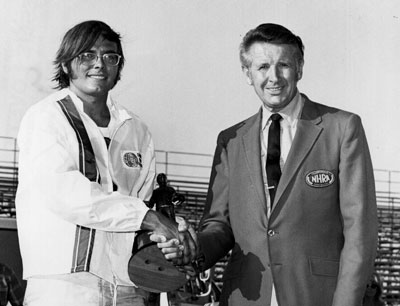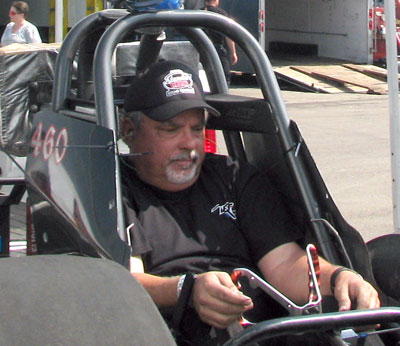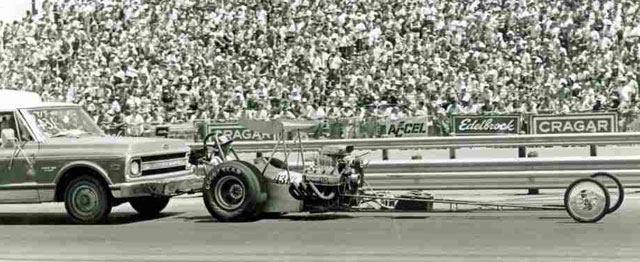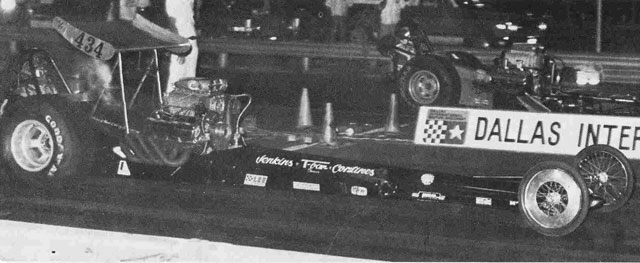

M&R revisited, and the tale of Bob Gibson
 After posting here last week about Roger “Riceman” Lee’s upcoming re-creation of the Masters & Richter Top Fueler, it didn’t take me long to get the expected reply about whether it was the ex-M&R car that “Big John” Milner drove in More American Graffiti, and the answer came from Lee himself, who also supplied the photos at right.
After posting here last week about Roger “Riceman” Lee’s upcoming re-creation of the Masters & Richter Top Fueler, it didn’t take me long to get the expected reply about whether it was the ex-M&R car that “Big John” Milner drove in More American Graffiti, and the answer came from Lee himself, who also supplied the photos at right.
“The Masters & Richter Fueler was never in More American Graffiti,” he emphatically wrote.
He also provided a timeline of the car that he’s restoring, which is actually the second (and better-known) M&R car. Driver “Big Bob” Haines rolled the original M&R car (also known as “Cigar Nose”) into the creek at Half Moon Bay Drag Strip when the parachute didn't come out. The car was later sold to Tom Prufer and replaced with a car that Kent Fuller had built in 1961 for Ronnie Hampshire and George Boltoff. That car had been sold to Jim McLennan and raced as the Champion Speed Shop Top Fueler that was driven by Sammy Hale with small-block Chevy power.
Masters and Richter bought the car from McLennan when McLennan had his hands full running Fremont Raceway, Half Moon Bay, and Champion Raceway (an eighth-mile strip in Brisbane, Calif.), even though at least one prominent writer in the weekly drag racing newspapers had opined that M&R’s big 392 Chrysler would never work in the car. The duo commissioned Fuller to reinforce the 112-inch chassis with more uprights and diagonals for the new engine, and by the end of 1963, they’d tuned the car to bests of 7.89 at 196.92 at Fremont.
The chassis was lengthened by crewmember Lefty Hay before it was sold to Tom Walsh and Hay, who raced it as the Wailer until 1968. In 1990, the car was resurrected and raced -- still painted as the Wailer -- with an alcohol-fed blown 392 by Mark Smith. The car was sold three more times and then reportedly was backhalved and raced with an injected big-block Chevy/Powerglide combination. The car owner passed away, and his son has it now, but the car is not for sale, although probably not much of the original car is still in it.
Thom Roy came to a similar conclusion just looking at photos of the movie car and the original, noting differences between, among other things, such items as length, tail extension, windshield, the channel of the bodywork, and the rear support of the roll bar.
I also heard from regular Insider commenter Dave LeRoy, who actually worked for the M&R team. “They had their shop in San Leandro, Calif., which housed the car in two bays. The other bays were for the 52 Kenworths they leased to Watson/Wilson trucking. We had a guy that worked for them in the shop that would go to all of the wrecking yards to find 392s a couple of days a week! I would mix fuel among other things; we would run some mixes that no one else ran. The car always sounded different than most fuel cars; ask Ivo. We held the top speed record for a long time and held the No. 2 Mr. Eliminator spot for a long time and took on several challengers, including Prudhomme and Ivo. Lots of great stories from those days!”
Indeed.


(Above) Bob Gibson then, accepting congratulations from Wally Parks after winning the 1970 Springnationals in Dallas, and (below) now.
|
 |
Friday’s column about Top Fuel seasons brought a great email from one of the subjects mentioned, Bob Gibson, who won Top Fuel at the 1970 Springnationals in Dallas while driving for the famed Carroll Bros. team, thanking me for not forgetting him. This is an all-too-common response from some of the early heroes, and it pains me to think that they think they have been relegated to the dark corners of the NHRA history book, never to see the light again.
There's no driver photo file for Gibson as there is for many, many drivers, and the reason is simple: His driving career spanned only five years.
“I had a short but sweet career at the top level, driving for John Dodson (A/Fuel 1967-68), Robert Landrum in ’69, and the Carroll Bros. in ’70 (we also won the Bayou State Championships in Houma that year). I drove Ray Godman’s Tennessee Bo-Weevil in ’71 (went three rounds at the ‘71 Gatornationals, IHRA Rockingham, and match races galore), Buddy Cortines (’71 Springnationals, first round), and finished up the year for Peebles & Williams at the ’71 World Finals (No. 1 qualifier east and low e.t. of the first round).
“TRW came calling, and I started my automotive sales career for them under a no-more-driving requirement. I worked the NHRA national events for TRW from ’72 to ’82 as an employee. Still at it today, living on the road and peddling shocks for KYB. I missed my chance to drive a rear-engine car and would have really liked that but did get to run Garlits’ new RED trendsetter.”
When Gibson won the Springnationals, he was only 22 and had to be NHRA’s youngest Top Fuel winner at that point (Jeb Allen, 18 years, 1 month, would win the Summernationals the following year and remains the youngest Top Fuel winner in NHRA history), and I asked him how he was accepted by the era’s veterans.

Gibson, in Buddy Cortines' winged front-engine Top Fueler at the 1971 Springnationals
|
“I may have once been the youngest,” he agreed. “Never thought of it until you mentioned it. Speaking of the grizzled old vets, once you outran a couple of them, especially with a holeshot, you were accepted. Some of them I can remember running against were ‘the Greek,’ Tharp, Nix, Nicoll, Safford, Garlits, Moody, Wiebe, ’the Goose’, Bernstein … some of the best at the time; never went up against ‘the Snake,’ though. The best advice I ever got from one of them -- at least that I remember – two-time world champ, Bennie Osborn, who is a man of few words, came up to me one time after a left front spindle broke on a rough LaPlace track, and the left front wheel promptly departed about 800 feet. Bob here never noticed, just kept my foot in it to 1,320. Pulled the chute followed by a shower-of-sparks stop. On a good run in the Carrolls’ old T-Bar FED, the left front always hiked up due to engine torque reaction and just kind of skipped along anyway, not really steering -- the right did all the guiding. Anyway, ol' Bennie just says, ‘Boy don’t ya know you need four wheels to drive one of these things?’ and walks away. LOL. By the way, we won that round and made the final.
“It was a great time to drive; at that age, you didn’t even think about the possible consequences. I never went on my head in a car, did get burned around the back of the neck in a blower explosion and fire once or twice, bounced off a guardrail, etc. The worst time I ever had was when the chute failed to open. I just ended up in the sand once at Oklahoma City with a well-bent-up car and a pretty good headache. I sure wouldn’t trade those experiences for anything. I certainly cherish my Wally.”
 |
Gibson also told me that he’s restoring a Cackle car, the last front-engine AA/Fueler that T-Bar chassis built for Cortines in 1971 that Gibson ran at the 1971 Springnationals (pictured above).
“I hope to have it ready for next year’s Reunions,” he said. “I crewed on Brad Green’s Arkansas NTF in ’08 and ’09 with Texas friends Dave Pace in the seat and John Dearmore tuning, where I found the thrill and attraction to blown fuel racing just as strong as ever.”
It's good to have this history out in the light again, and it's always wonderful for me to see when something I have written has touched someone and made him or her remember that some of us will never forget.



















































